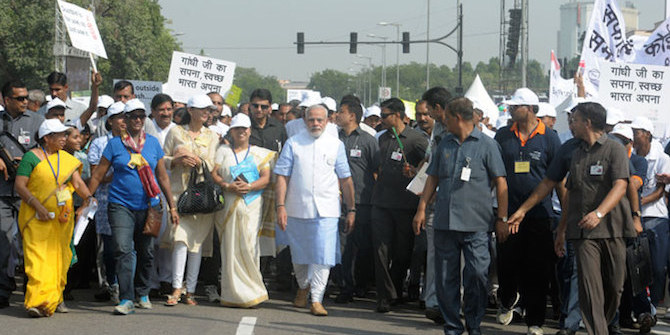 How large are the benefits of transportation infrastructure projects, and what explains these benefits? Dave Donaldson investigates the impact of the railway network in colonial India and finds it improved the trading environment and generated considerable welfare gains.
How large are the benefits of transportation infrastructure projects, and what explains these benefits? Dave Donaldson investigates the impact of the railway network in colonial India and finds it improved the trading environment and generated considerable welfare gains.
In 2007, almost twenty percent of World Bank lending was allocated to transportation infrastructure projects, a larger share than that of education, health and social services combined. These projects aim to reduce the costs of trading, yet despite this emphasis we lack a rigorous empirical understanding of the extent to which transportation infrastructure projects impact costs of trading, and how the resulting reductions in trade costs affect welfare.
In my paper Railroads of the Raj: Estimating the Impact of Transportation Infrastructure I exploited one of history’s great transportation infrastructure projects – thevast network of railroads built in colonial India (India, Pakistan and Bangladesh; henceforth,simply “India”) – to extend our understanding of transportation infrastructure improvements.

The railroad network designed and built by the British government in India brought dramatic change to the technology of trading on the subcontinent. Prior to the railroad age, bullocks carried most of India’s commodity trade on their backs, traveling no more than 30 km per day. By contrast, railroads could transport these same commodities 600 km in a day, and at much lower per unit distance freight rates. As the 67,247 km long railroad network expanded from 1853 to 1930, it penetrated inland districts (local administrative regions), connecting them with the rest of India and the world.
The British government collected detailed records of economic activity throughout India in this time period – remarkably, however, these records have never been systematically digitised and organised by researchers. It was these records that I used to construct a new, district-level dataset on prices, output, daily rainfall and interregional and international trade, as well as a digital map of India’s railroad network in which each 20 km segment is coded with its year of opening. This dataset allowed me to track the evolution of India’s district economies before, during, and after the expansion of the railroad network.
The availability of records on interregional trade is particularly unique and important. Information on trade flows within a country is rarely available to researchers, yet the response of these trade flows to a transportation infrastructure improvement says a great deal about the potential for gains from trade. I utilised a Ricardian trade model (following the influential work of Eaton and Kortum, 2002) to assess empirically the importance of one particular mechanism linking railroads to welfare improvements – that railroads reduced trade costs and thereby allowed regions to gain from trade. The model serves to demonstrate that India’s railroad network improved the trading environment and generated welfare gains, and also suggests that these welfare gains arose predominantly because railroads allowed regions to exploit gains from trade.
Railroads of the Raj therefore made three specific contributions to our understanding of the effects of large transportation infrastructure projects in the context of an enormous expansion:
- By estimating the effect of India’s railroads on the national trading environment and demonstrating that railroads reduced the cost of trading, reduced interregional price gaps and increased trade volumes.
- By estimating the effect of India’s railroads on a proxy for economic welfare in colonial India. When the railroad network was extended to the average district, real agricultural income in that district rose by approximately 16 percent. While it is possible that railroads were deliberately allocated to districts on the basis of time-varying characteristics unobservable to researchers today, I found little evidence for this potential source of bias to my results. In particular, railroad line projects that were scheduled to be built but were then cancelled for plausibly idiosyncratic reasons display no spurious ‘effects’ on economic growth.
- By shedding light on the mechanisms at work by relating the observed railroad-driven reduction in trade costs to the observed railroad-driven increase in welfare.
As in much of the developing world today, colonial India’s precarious monsoon rains and its rain-fed agricultural technologies made real income volatility extremely high. Famines were a perennial concern. While the findings in Railroads of the Raj argue that railroads caused an increase in the level of real incomes in India, a component of economic welfare that it has been silent on concerns this volatility of real incomes over time. An important question for future research concerns the extent to which transportation infrastructure systems like India’s railroad network can help regions to smooth away the effects of local weather extremes on local well-being. Robin Burgess and I have conducted a preliminary analysis of these effects here.
This blog is based on Dave Donaldson’s paper Railroads of the Raj: Estimating the Impact of Transportation Infrastructure. The full paper can be viewed here.
About the Author
 Dave Donaldson is Associate Professor of Economics at Stanford University. He completed both his Masters and PhD at the LSE.
Dave Donaldson is Associate Professor of Economics at Stanford University. He completed both his Masters and PhD at the LSE.







1 Comments